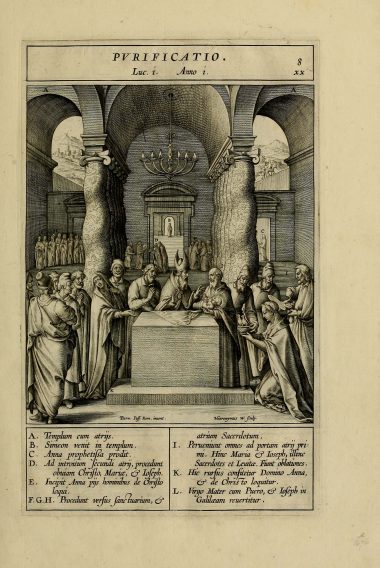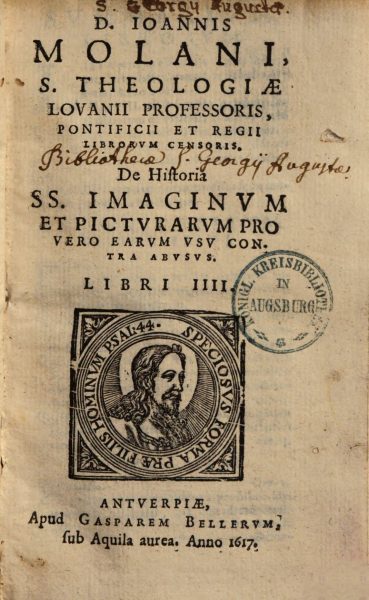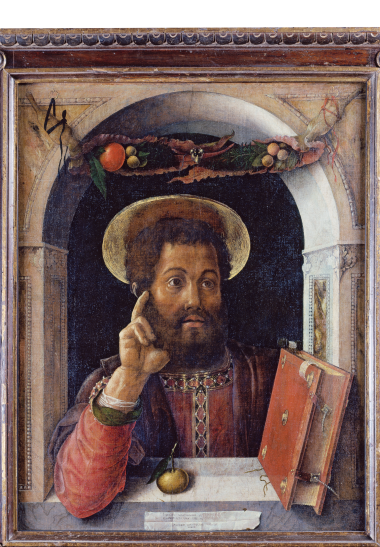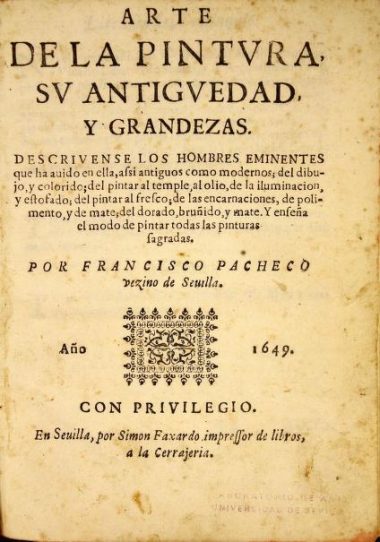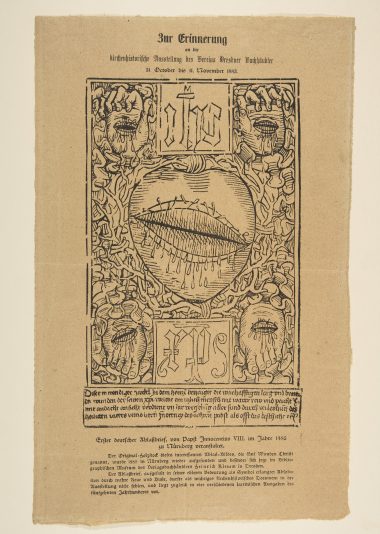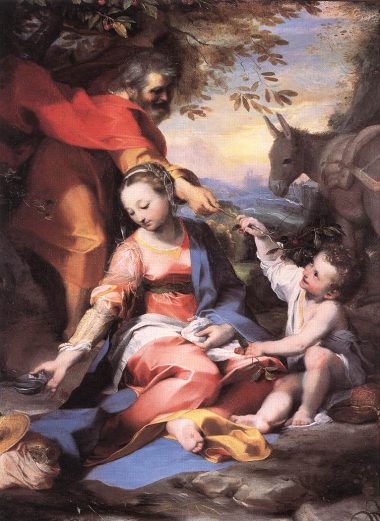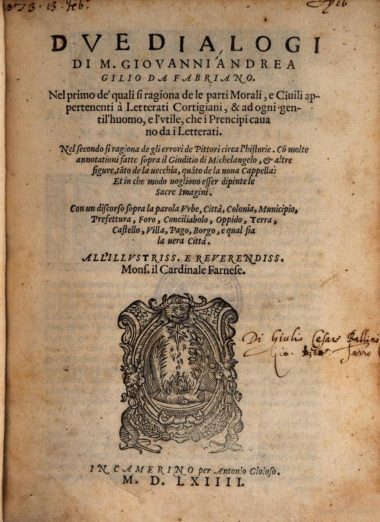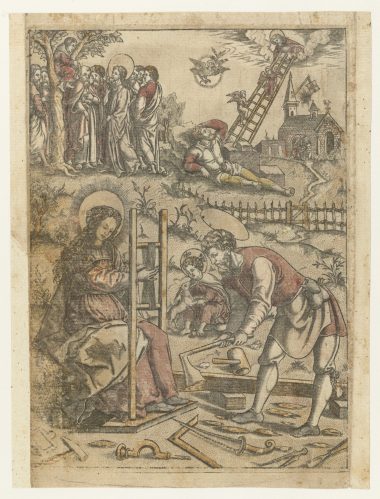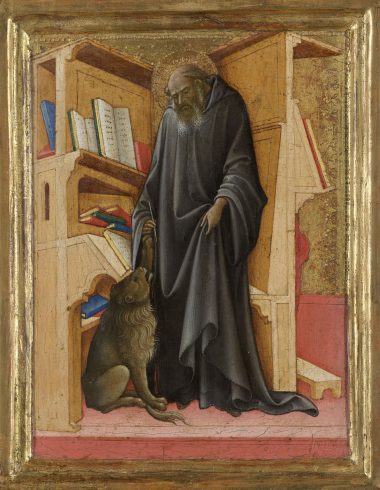How to depict the “presentation of the Christ-child in the temple”
Using one artwork made by Jeronimo Nadal and one painted by Mase Pedro Campaña as examples, Pacheco analysed how to represent the story about the presentation of the Christ-child in the temple.
Paintings are living scripture and also of great use to the educated to avoid sins
Molanus discusses another time the usefulness of ancient images to those who have fallen into sin or who run the risk of doing so, this is also true for the educated.
Images with harmless erros can be left in place to avoid unrest among the populace
Molanus comments on iconographies which are derived from apocryphal sources, in particular those which are well spread among the populace. His stance on this matter is rather balanced: as long as the artworks do not contain any dangerous errors and they have been approved by the regional authority, they do not have to be taken away from their respective locations so that common people could not be disturbed by such actions.
Only artworks approved by the Bishop can be placed in churches or other public places
Molanus reaffirms the viewpoints of the Council of Trent that only artworks approved by churchly authorities should be allowed to decorate churches; he illuminates this with an example of St. Mark.
Preserving an image of parents and ancestors is allowed
Molanus defends the use of images of parents and other ancestors.
Anna Ynes does not believe in the image of the crucifix
The Old Christian Anna Ynes called “christianellos” the people who have in their ceremony the crucifix close to the bed when is given to the sick the extreme unction.
The mistake of depicting the Holy Trinity in the Virgin Mary’s womb
Pacheco desaproved the painting of the Holy Trinity in the Virgin Mary’s womb since such composition seems as “if all the three divine Persons had clothed themselves in our flesh.”
On his way to Jerusalem Saul fell from his horse blinded by the light of Jesus’ appearance
Molanus argues that in the story of the Conversion of Saul it is very likely that he was riding a horse, as is often depicted by painters, despite the lack of reference to this in the Scriptures.
The depiction of the wounds of Christ
Molanus argues that the depiction of Christ’s wounds is incorrect and the prevalence of these paintings is the popularity among the commoners, however, it does not constitute a dangerous error.
The depiction of the Virgin Mary
Molanus refers to Epiphanius for the correct depiction of the Virgin Mary: as a humble and graceful woman.
Letter of the Suprema to the inquisitors of the city of Valencia warning of the entry into the kingdom of “pernicious” canvases
Letter from the Suprema to the inquisitors of the city of Valencia warning of the entry into the kingdom of “pernicious” canvases.
Depiction of mary dressed indecently
Pacheco states that Mary must be depicted decently in her Betrothal scene. The artist Don Luis Pascual was criticised by the Spanish author, whose painting shows a Virgin Mary not dressed “appropriately in correspondence to Her greatness and importance”. The reason for such criticism is because the artist depicted her without a mantle, “with a large Venetian skirt very tucked into the waist, full of many bows of colored ribbons and with large sleeves”. (Pacceho 1990, book 3, ch.12, 591-592)
Almanacs are superstitious
Molanus condemns the use of Almanacks since they display dangerous images and false doctrines
Sacred and profane paintings that promote indecency should be prohibited
Molanus calls for the prohibition of sacred and profane paintings that deliberately discuss, recount or teach indecent or obscene matters, like is the case for books.
The unworthiness of the pagan gods comes forward in their appearance
Molanus condemns and ridicules the pagan gods and names several of them: Vulcan, Apollo, Saturn, Diana, Mercury, Pan, June, and Neptune.
The saints are just poles
Juan de la Fuente affirmed that for testing the power of the saint – that is, to believe in “those stick saints” – the person should take the object to a river and if the saint went upriver he could well believe in him, and if not “he was a piece of the stick”.
Painting the flight into Egypt scene versus The return from Egypt scene
Pacheco when analysing the scenes about the flight into Egypt and the return from there, observes that the artists did not pay attention to some elements concerning these two different moments, mainly concerning the passage of time and the different ages of Christ as a child in such scenes.
Painting the flight into Egypt scene versus The return from Egypt scene
Pacheco when analysing the scenes about the flight into Egypt and the return from there, observes that the artists did not pay attention to some elements concerning these two different moments, mainly concerning the passage of time and the different ages of Christ as a child in such scenes.
Paintings visually reproduce a holy story and thus must be venerated with the same devotion
Molanus argues that paintings are the visual reproduction of a written story, therefore they should receive the same devotion while venerated as the texts themselves.
Joseph holding an axe and other apocryphal subjects are allowed
Molanus argues that, despite the lack of reference in the Scripture, depicting Joseph with an axe does not pose an error.
How to depict death in painting
Molanus calls for caution from artists in the depiction of death since nothing is more uncertain than the moment one passes away.
Crowns or other attributes in the images of Saints to emphasise their virtue
Molanus discusses attributes, like crowns, halos and the like in the depictions of saints, they represent the four cardinal virtues.
Rodrigo de Velasco mocked a sculpted and painted image of the crucifix which was in the prison
The Portuguese Rodrigo de Velasco was denounced by a prison companion



